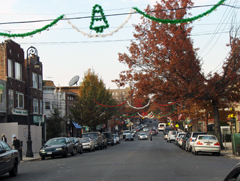Woodlawn

The nineteenth-century taste for landscaped, park-like burial grounds was gratified by the opening of Woodlawn Cemetery in 1865. Unlike its predecessor, Brooklyn's Green-Wood, rural Woodlawn could be easily reached from Manhattan on the Harlem railroad, which had entered the area in the 1840s. The burial of Admiral David Farragut in 1870 established the reputation of Woodlawn with the New York elite, many of whom commissioned prominent architects to design their mausoleums on the Bronx River hillside. The neighborhood grew with the cemetery. In 1873 forty to fifty houses in the area just to the north, once part of Philipse manor, later the farm of Gilbert Valentine, were incorporated as the village of Woodlawn. The Irish and Italian character of the area was determined in the 1890s, when the construction of the second Croton Aqueduct brought a new population of workers to the village.
[Back to Index]